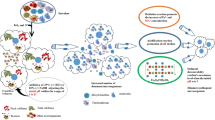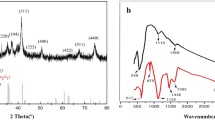Abstract
Purpose
The aim of this study was to investigate biodegradation of γ-hexabromocyclododecane (γ-HBCDD) under conditions mimicking three bioremediation strategies: (i) biostimulation: addition of sodium formate and ethanol to stimulate biodegradation as the carbon source and electron donor, respectively; (ii) bioaugmentation: addition of an enrichment culture of Dehalobium chlorocoercia strain DF-1; and (iii) natural attenuation: no amendments. To differentiate between biotic and abiotic mechanisms affecting γ-HBCDD degradation, four control microcosms were set up as sterile, negative, abiotic, and contaminant control.
Materials and methods
Sediment microcosms were prepared in 20-mL bottles and operated as duplicate sacrificial reactors with a sediment-to-liquid ratio of 3 g wet solid:3.5 mL liquid. Total incubation time was 36 days with sampling every 4 days, except the last day. γ-HBCDD contents of sediments were extracted using ultrasonication and analyzed using GC-MS. Four control microcosms were used to observe the effect of (i) microbial activity (sterilization with mercuric chloride and autoclaving), i.e., sterile; (ii) microbial culture without DF-1 cells, i.e., negative control; (iii) sediments, where kaolinite is used instead of sediments, i.e., abiotic control; and (iv) γ-HBCDD, where no analyte is added, i.e., contaminant control.
Results and discussion
Biostimulation showed the highest γ-HBCDD biodegradation rate (k = 0.0542 day−1) and enhanced biodegradation compared to natural attenuation (k = 0.0155 day−1). Bioaugmentation (k = 0.0123 day−1) with DF-1 strain showed a sharp decrease at the beginning, but could not maintain this trend afterwards. Paired comparison of microcosms yielded no statistically significant difference between bioaugmentation and natural attenuation; hence, DF-1 strain did not improve degradation when compared to natural attenuation. This was also substantiated by observations from the negative control set. Sterile and abiotic control sets showed no significant concentration change in time. Consequently, adsorption was not considered as a significant mechanism acting on γ-HBCDD concentration change in our sediment microcosms. Thus, γ-HBCDD decrease observed in bioremediation microcosms was attributed to microbial activity.
Conclusions
We reported effective analyte degradation with biostimulation. This was the first study to test bioaugmentation for HBCDD degradation, but we observed no enhancement of degradation with the DF-1 strain tested. Previous studies observed HBCDD reduction in their sterilized controls, hence reported total biotic and abiotic degradation rate. In this study, comparative evaluation of three test and four control microcosms enabled identification of only anaerobic biodegradation rates for γ-HBCDD, providing useful information for bioremediation of contaminated sites.



Similar content being viewed by others
References
Bedard DL (2003) Polychlorinated biphenyls in aquatic sediments: environmental fate and outlook for biological treatment. In: Haggblom MM, Bossert ID (eds) Dehalogenation: microbial processes and environmental applications. Kluwer Academic Publishers, Boston, pp 443–465
Berkaw M, Sowers KR, May HD (1996) Anaerobic ortho dechlorination of polychlorinated biphenyls by estuarine sediments from Baltimore Harbor. Appl Environ Microbiol 62:2534–2539
Chang BV, Shiung LC, Yuan SY (2002) Anaerobic biodegradation of polycyclic aromatic hydrocarbon in soil. Chemosphere 48:717–724
Covaci A, Gerecke AC, Law RJ, Voorspoels S, Kohler M, Heeb NV, Leslie H, Allchin CR, de Boer J (2006) Hexabromocyclododecanes ( HBCDs ) in the environment and humans: a review. Environ Sci Technol 40:3679–3688
Davis JW, Gonsior S, Marty G, Ariano J (2005) The transformation of hexabromocyclododecane in aerobic and anaerobic soils and aquatic sediments. Water Res 39:1075–1084
Davis JW, Gonsior SJ, Markham DA, Friederich U, Hunziker RW, Ariano JM (2006) Biodegradation and product identification of [14C]hexabromocyclododecane in wastewater sludge and freshwater aquatic sediment. Environ Sci Technol 40:5395–5401
Demirtepe H (2017) Sustainable remediation of aquatic sediments contaminated with polybrominated diphenyl ethers and hexabromocyclododecane. Ph.D. Dissertation, Middle East Technical University, Ankara, Turkey
Demirtepe H, Imamoglu I (2019) Degradation of decabromodiphenyl ether (BDE-209) in microcosms mimicking sediment environment subjected to comparative bioremediation strategies. J Environ Manag 233:120–130
European Commission (2008) Risk assessment hexabromocyclododecane. European Communities, Luxembourg
Gerecke AC, Giger W, Hartmann PC, Heeb NV, Kohler HPE, Schmid P, Zennegg M, Kohler M (2006) Anaerobic degradation of brominated flame retardants in sewage sludge. Chemosphere 64:311–317
Ghattas AK, Fischer F, Wick A, Ternes TA (2017) Anaerobic biodegradation of (emerging) organic contaminants in the aquatic environment. Water Res 116:268–295
Guerra P, Eljarrat E, Barceló D (2008) Enantiomeric specific determination of hexabromocyclododecane by liquid chromatography-quadrupole linear ion trap mass spectrometry in sediment samples. J Chromatogr A 1203:81–87
He M-J, Luo X-J, Yu L-H, Wu JP, Chen SJ, Mai BX (2013) Diasteroisomer and enantiomer-specific profiles of hexabromocyclododecane and tetrabromobisphenol A in an aquatic environment in a highly industrialized area, South China: vertical profile, phase partition, and bioaccumulation. Environ Pollut 179:105–110
Heiri O, Lotter AF, Lemcke G (2001) Loss on ignition as a method for estimating organic and carbonate content in sediments: reproducibility and comparability of results. J Paleolimnol 25:101–110
Himmelheber DW, Hughes J (2014) In situ biotransformation of contaminants in sediments. In: Reible DD (ed) Processes, assessment and remediation of contaminated sediments. Springer, New York, USA
Karahan I (2018) Investigation of biotic degradation of hexabromocyclododecane (HBCDD). MS Thesis, Middle East Technical University, Ankara, Turkey
Klosterhaus SL, Stapleton HM, La Guardia MJ, Greig DJ (2012) Brominated and chlorinated flame retardants in San Francisco Bay sediments and wildlife. Environ Int 47:56–65
Le TT, Son M-H, Nam I-H et al (2017) Transformation of hexabromocyclododecane in contaminated soil in association with microbial diversity. J Hazard Mater 325:82–89
Li H, Zhang Q, Wang P, Li Y, Lv J, Chen W, Geng D, Wang Y, Wang T, Jiang G (2012) Levels and distribution of hexabromocyclododecane (HBCD) in environmental samples near manufacturing facilities in Laizhou Bay area, East China. J Environ Monit 14:2591–2597
Magar VS, Brenner RC, Johnson GW, Quensen JF (2005) Long-term recovery of PCB-contaminated sediments at the Lake Hartwell superfund site: PCB dechlorination. 2. Rates and extent. Environ Sci Technol 39:3548–3554
Marvin CH, Tomy GT, Armitage JM, Arnot JA, McCarty L, Covaci A, Palace V (2011) Hexabromocyclododecane: current understanding of chemistry, environmental fate and toxicology and implications for global management. Environ Sci Technol 45:8613–8623
May HD, Sowers KR (2016) “Dehalobium chlorocoercia” DF-1 - from discovery to application. In: Adrian L, Löffler FE (eds) Organohalide-respiring bacteria. Springer, Berlin Heidelberg, Germany, pp 563–586
National Research Council (2003) Bioavailability of contaminants in soils and sediments processes, tools and applications. National Academies Press, Washington DC
Nelson DW, Sommers LE (1996) Total carbon, organic carbon, and organic matter. In: Sparks DL, Page AL, Helmke PA et al (eds) Methods of soil analysis. Part 3—chemical methods. Soil Science Society of America, Inc., Madison, pp 961–1010
Payne RB, May HD, Sowers KR (2011) Enhanced reductive dechlorination of polychlorinated biphenyl impacted sediment by bioaugmentation with a dehalorespiring bacterium. Environ Sci Technol 45:8772–8779
Payne RB, Fagervold SK, May HD, Sowers KR (2013) Remediation of polychlorinated biphenyl impacted sediment by concurrent bioaugmentation with anaerobic halorespiring and aerobic degrading bacteria. Environ Sci Technol 47:3807–3815
Peng X, Huang X, Jing F, Zhang Z, Wei D, Jia X (2015) Study of novel pure culture HBCD-1, effectively degrading hexabromocyclododecane, isolated from an anaerobic reactor. Bioresour Technol 185:218–224
Peng Y-H, Chen Y, Chang M, Shih Y (2018) The effect of zerovalent iron on the microbial degradation of hexabromocyclododecane. Chemosphere 200:419–426. https://doi.org/10.1016/j.chemosphere.2018.02.123
Semple KT, Doick KJ, Jones KC, Burauel P, Craven A, Harms H (2004) Defining bioavailability and bioaccessibility of contaminated soil and sediment is complicated. Environ Sci Technol 38:228A–231A
Site AD (2001) Factors affecting sorption of organic compounds in natural sorbent/ water systems and sorption coefficients for selected pollutants. A review. J Phys Chem Ref Data 30:187–439
Speece RE (1996) Anaerobic biotechnology for industrial wastewaters. Archae Press, Nashville
Stiborova H, Vrkoslavova J, Pulkrabova J, Poustka J, Hajslova J, Demnerova K (2015) Dynamics of brominated flame retardants removal in contaminated wastewater sewage sludge under anaerobic conditions. Sci Total Environ 533:439–445
Stockholm Convention (2018) Stockholm Convention Website. http://chm.pops.int/TheConvention/ThePOPs/. Accessed 1 Oct 2018
Tokarz JA III, Ahn M-Y, Leng J et al (2008) Reductive debromination of polybrominated diphenyl ethers in anaerobic sediment and a biomimetic system. Environ Sci Technol 42:1157–1164
USEPA (1996) Method 3665A sulfuric acid/permanganate cleanup, Revision 1, December 1996, Final Update III to the Third Edition of the Test Methods for Evaluating Solid Waste, Physical/Chemical Methods, EPA publication SW‐846
Wu Q, Milliken CE, Meier GP, Watts JEM, Sowers KR, May HD (2002) Dechlorination of chlorobenzenes by a culture containing bacterium DF-1, a PCB dechlorinating microorganism. Environ Sci Technol 36:3290–3294
Yamada T, Takahama Y, Yamada Y (2009) Isolation of Pseudomonas sp. strain HB01 which degrades the persistent brominated flame retardant gamma-hexabromocyclododecane. Biosci Biotechnol Biochem 73:1674–1678
Zhang Y, Lu Y, Wang P et al (2018) Transport of hexabromocyclododecane (HBCD) into the soil, water and sediment from a large producer in China. Sci Total Environ 610–611:94–100
Acknowledgements
The authors would like to thank Prof. Kevin R. Sowers for providing the microbial strain.
Funding
This study was funded by Middle East Technical University Research Fund (Project No. BAP-03-11-2014-002) and The Scientific and Technological Research Council of Turkey (TUBITAK Project No. 115Y122).
Author information
Authors and Affiliations
Corresponding author
Ethics declarations
Conflict of interest
The authors declare that they have no conflict of interest.
Additional information
Responsible editor: Gijs D. Breedveld
Publisher’s note
Springer Nature remains neutral with regard to jurisdictional claims in published maps and institutional affiliations.
Electronic supplementary material
ESM 1
(DOCX 483 kb)
Rights and permissions
About this article
Cite this article
Demirtepe, H., Imamoglu, I. Biostimulation enhanced the biotic degradation of hexabromocyclododecane in sediments. J Soils Sediments 19, 2859–2868 (2019). https://doi.org/10.1007/s11368-019-02280-z
Received:
Accepted:
Published:
Issue Date:
DOI: https://doi.org/10.1007/s11368-019-02280-z




